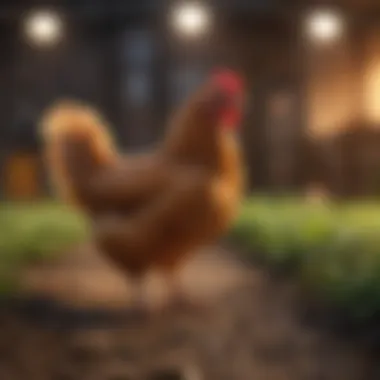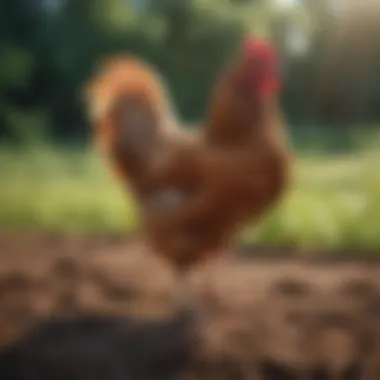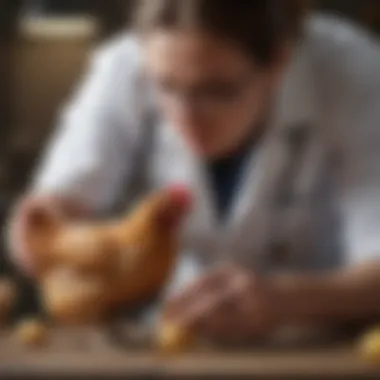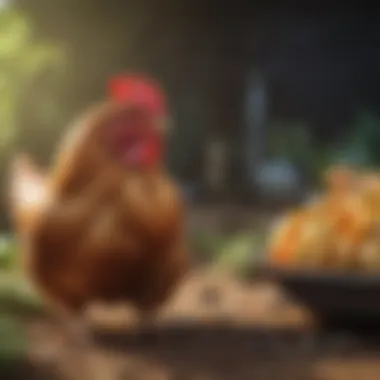Understanding Chicken Crop Impaction: Causes and Remedies


Intro
Chicken crop impaction can significantly affect a chickens health and overall well-being. This condition occurs when the crop—an essential part of a chicken's digestive system—becomes blocked. Understanding the causes, symptoms, and treatments is crucial for any chicken owner. In this article, we will provide a detailed look into the specifics of crop impaction, highlighting key points that chicken owners must know for proper management.
Causes of Crop Impaction
There are several factors that contribute to crop impaction in chickens. Among these, diet plays a significant role. Feeding chickens coarse, dry foods can lead to impaction. Overeating or consuming large amounts of fibrous material from plants can also cause blockage. Other contributing factors include:
- Poor hydration: Lack of water can lead to dry food in the crop, making it difficult to digest.
- Inadequate grit: Chickens require grit to help grind their food in the digestive process.
- Health conditions: Certain illnesses or infections can impair digestive function.
Understanding these causes helps in preventing crop impaction. Monitoring the diet and ensuring access to fresh water are vital steps that owners should take.
Symptoms of Crop Impaction
Recognizing symptoms early is key to addressing crop impaction before it becomes serious. Common symptoms include:
- Swollen crop: A distended or firm crop may indicate blockages.
- Loss of appetite: If a chicken refuses to eat, it can be a sign of digestive distress.
- Lethargy: Reduced activity levels may occur, which owners should not ignore.
- Regurgitation: Frequent regurgitation of undigested food is a major indicator.
If you notice any of these symptoms, it is crucial to take quick action.
Diagnosis of Crop Impaction
Diagnosing crop impaction typically involves a physical examination of the chicken. A veterinarian will assess the crop's size and shape, listening for any unusual sounds. In some cases, imaging may be used to confirm the diagnosis. Timely diagnosis is essential for effective treatment.
Treatment Options
Treatment for crop impaction can vary depending on the severity of the condition. Here are some common approaches:
- Massage: Gently massaging the crop can help stimulate digestion.
- Hydration: Providing electrolyte solutions can assist in breaking down the blockage.
- Veterinary intervention: Severe cases may require professional care, including surgical removal of the obstruction.
It is essential to act quickly if you suspect crop impaction. The sooner you treat it, the better the chances for recovery.
Prevention Strategies
Maintaining a healthy diet is paramount for preventing crop impaction. Here are some preventative measures:
- Balanced feed: Ensure that chickens receive a diet balanced in nutrients, avoiding large amounts of dry, fibrous materials.
- Provide grit: Regularly offer grit to assist in the digestive process.
- Fresh water: Always keep fresh and clean water available.
By incorporating these strategies, owners can lessen the likelihood of crop impaction.
Ending
In summary, understanding chicken crop impaction is crucial for maintaining the health of your flock. By knowing the causes, symptoms, and treatments, you can manage your chickens' well-being. Implementing prevention tactics can go a long way in ensuring a healthy and thriving group of chickens.
Preface to Chicken Crop Impaction
Chicken crop impaction is a critical issue for poultry owners. Managing the health of chickens goes beyond basic care; it entails an understanding of various health conditions, such as crop impaction. This condition occurs when a chicken's crop, an essential part of its digestive system, becomes obstructed. The significance of this topic cannot be overstated, as crop impaction can lead to serious health concerns and affect a chicken’s overall wellbeing.
Understanding crop impaction is beneficial for several reasons. First, recognizing the symptoms early can help prevent severe complications. Signs can often be subtle, making awareness crucial for timely intervention. Second, knowing the causes of impaction can aid in effective prevention, ensuring that the diet and environment of your flock are optimal.
With proper guidance, chicken owners can mitigate risks associated with crop impaction. This article aims to provide a comprehensive look at the causes, symptoms, treatments, and preventive measures related to this condition. Owners can utilize this knowledge to enhance their chickens’ health and longevity.
Remember: Regular assessment of your chickens’ digestive health can lead to early detection and treatment.


In summary, being informed about chicken crop impaction not only improves the welfare of the birds but also cultivates responsible ownership. As you delve further into this article, you will find valuable insights aimed at ensuring the health of your flock.
Understanding the Chicken Crop
Understanding the chicken crop is essential for anyone interested in poultry health. The crop plays a vital role in the digestive process, acting as a temporary storage pouch for food. By grasping its anatomy and functions, chicken owners can identify problems early on, such as crop impaction, which can lead to serious health issues. A well-functioning crop ensures that chickens efficiently process their food, absorbing nutrients and maintaining their overall health.
Knowing how the crop works allows owners to make informed choices about diet and care. It enables them to provide appropriate feed and monitor changes that may indicate a problem. Recognizing signs of crop impaction quickly can prevent further complications, making this knowledge invaluable for each chicken keeper.
Anatomy of the Crop
The crop itself is a pouch-like structure located near the neck of the chicken. It is part of the avian digestive system and connects to the esophagus. This muscular sac can stretch to hold various amounts of food. Its size and shape can change depending on the amount of feed a chicken consumes.
- The crop wall consists of muscle and is lined with a mucous membrane, which helps in lubrication.
- Opening into the crop is the esophagus, through which food enters.
- Does not break down food chemically, unlike the stomach, but plays a vital role in storage.
Function of the Crop in Digestion
The primary function of the crop is to store food temporarily. After a chicken eats, the food enters the crop before moving to the stomach. This allows chickens to eat quickly, which is advantageous in the wild. The crop also works to moisten food, preparing it for the next stages of digestion.
Food in the crop is not digested immediately. Instead, it allows chickens to sieve through roughage. This process is crucial, as it means that birds can consume a variety of foods without choking. The crop helps in regulating the amount of food that reaches the stomach.
An efficient crop is key to a chicken's health, as it directly influences digestion.
In summary, understanding the chicken crop allows owners to appreciate the bird's digestive process more deeply. Recognizing the crop's anatomy and functions leads to better management of health issues such as crop impaction.
Causes of Crop Impaction in Chickens
Understanding the causes of crop impaction is essential for any chicken owner. Recognizing these causes can lead to effective management and prevention strategies. Crop impaction not only causes discomfort to chickens but can also disrupt their overall health. A well-informed owner can make better choices to safeguard their birds from these issues. There are three main categories that contribute to crop impaction: diet, environment, and behavior.
Inappropriate Diet
The diet of chickens plays a pivotal role in their health and digestion. An imbalance in nutrients or the presence of unsuitable food can lead to crop impaction. Common issues include:
- Low-quality feed: If the feed lacks essential nutrients or fiber, it can contribute to blockages.
- Excessive grains: Chickens often enjoy grains, but too many can result in a lack of roughage, leading to impaction.
- Inedible objects: Sometimes, chickens may consume items that are not food, which can obstruct the crop. This can include anything from plastic to small stones.
To mitigate these risks, it is crucial to provide a balanced diet that includes a variety of grains, seeds, and fresh vegetables. Regularly monitoring the feed intake can help in preventing dietary-related crop impactions.
Environmental Factors
Environmental conditions significantly influence a chicken's overall well-being. Factors that can contribute to crop impaction include:
- Poor housing conditions: Inadequate ventilation, overcrowding, or excessive moisture can stress chickens and lead to digestive problems.
- Access to harmful materials: Chickens should be kept in safe environments to avoid ingesting unsuitable items from their surroundings.
- Stressors from predators or other animals: Stress due to external threats can influence a chicken's feeding habits, often leading them to eat quickly and indiscriminately.
Paying attention to environmental factors and ensuring a safe and comfortable habitat can enhance the health of the flock and minimize the risks associated with crop impaction.
Behavioral Issues
Chickens, like many animals, exhibit certain behaviors that can sometimes predispose them to digestive issues. Key behavioral factors include:
- Rapid eating: Chickens that eat too quickly may swallow large pieces of food or inedible materials that can cause blockages.
- Foraging habits: Chickens that are allowed to roam may eat various items, some of which may not be suitable.
- Competition for food: In flocks where dominant birds push others aside, subordinate chickens may rush to eat, increasing their likelihood of crop issues.
To address these behavioral issues, providing enough feeding space, ensuring constant access to food, and monitoring feeding times can promote healthy eating habits among chickens. Proper management and awareness can lead to better digestion and overall well-being.
Understanding these causes provides a foundation for preventing crop impaction. Prevention not only enhances the chicken's health but also improves the overall productivity of the flock.


Symptoms of Crop Impaction
Recognizing the signs of crop impaction in chickens is crucial for timely intervention. An early understanding of symptoms helps poultry owners prevent severe complications. Chicken crop impaction can lead to discomfort and potential serious health issues if ignored. Owners must be vigilant about specific indicators that can suggest a blockage in the digestive system.
Physical Signs to Observe
Several physical signs can indicate that a chicken is suffering from crop impaction. Owners should watch for:
- Swollen Crop: One of the most apparent signs is a visibly enlarged crop. This swelling can often be felt during handling.
- Hardness: If the crop feels hard rather than soft, this may suggest that it is impacted. A healthy crop should feel pliable.
- Dehydration: Chickens with crop impaction may exhibit signs of dehydration. They might have dry beaks or sunken eyes.
- No Food Intake: If a chicken stops eating or drinking, this could indicate a problem with the crop.
- Poor Feather Condition: A lack of nutrition due to impaction can lead to poor feathering and overall poor health.
It is essential to examine the crop closely and regularly. Prompt identification of these signs may allow for quick action before the issue worsens.
Behavioral Changes
Behavioral changes can reflect a chicken’s physical discomfort. Observing a chicken’s behavior aids in recognizing crop impaction. Common behavioral changes include:
- Inactivity: Chickens may become less active. They often remain in one spot or seem lethargic.
- Ruffling Feathers: Chickens may display ruffled feathers, indicating discomfort.
- Vocalizations: Increased vocalization or unusual sounds might signal distress.
- Feather Plucking: In some cases, a chicken might begin to pluck its feathers as a response to discomfort.
- Gurgling Sounds: Unusual sounds coming from the crop area can signal digestive trouble.
These behavioral changes can provide insight into a chicken's health. Owners should take note of any unusual behavior.
Timing of Symptoms
Understanding when symptoms of crop impaction might arise is helpful for timely management. Symptoms usually occur after feeding times. If a chicken has not shown signs of distress within a few hours of eating, it may indicate that the crop is functioning normally.
- Immediate Reactions: Signs may present soon after feeding if there’s an issue with the food. For example, if the food is too dry or too coarse, it can lead to immediate blockage.
- Delayed Reactions: In some cases, symptoms can appear hours or even days later. This delay may occur if the chicken is consuming fibrous materials that do not pass easily.
- Chronic Cases: For ongoing issues, signs may fluctuate. A chicken may seem okay one day and exhibit signs of impaction the next, leading to confusion for owners.
By monitoring both timing and symptoms, poultry owners can better address the condition of their chickens. The prompt recognition of these signs is an essential first step toward effective treatment and management.
Diagnosis of Crop Impaction
Diagnosing crop impaction is vital for the health and well-being of chickens. Early detection can prevent further complications and enhance recovery. Understanding how to properly assess chickens for this condition allows owners to respond effectively. Addressing crop impaction promptly helps ensure that a chicken's digestive function is restored quickly, reducing discomfort and the risk of more severe health issues.
Veterinary Examination Process
The veterinary examination process is a crucial step in diagnosing crop impaction. When a chicken shows symptoms, a veterinarian will conduct a thorough examination. This often involves:
- Physical Inspection: The vet will palpate the crop to assess its size and consistency. A firm, distended crop is a common sign of impaction.
- Weight Assessment: Weighing the chicken can help evaluate its overall health and determine if weight loss has occurred due to feeding difficulties.
- Listening for Sounds: The veterinarian might listen for digestive sounds, as an absence of normal sounds can indicate blockage.
These steps help in obtaining an accurate diagnosis. Understanding the animal’s history is also important. Dietary habits and changes in the environment can provide context for the examination findings.
Diagnostic Tools and Techniques
Diagnostic tools and techniques are essential in confirming crop impaction. Veterinarians may utilize various methods, including:
- Endoscopy: This technique allows for direct visualization of the crop and esophagus. It helps in determining the exact nature of the blockage.
- X-rays: Radiographs can reveal the presence of foreign objects and assess the level of impaction. They help in understanding whether the blockage is severe or minor.
- Ultrasound: An ultrasound can be another method to visualize the crop, especially in complicated cases.
Knowing the right diagnostic tools helps veterinarians make informed decisions. Making the right diagnosis is critical in formulating the appropriate treatment plan.
Properly diagnosing crop impaction is not only about identifying the issue but also about understanding the underlying causes. With correct identification, effective treatment and management strategies become possible. This is essential in ensuring the long-term health of the chicken.
Treatment and Management
Effective treatment and management of chicken crop impaction is crucial for ensuring the health and well-being of affected birds. Understanding how to treat crop impaction not only alleviates the immediate discomfort for chickens but also helps prevent future occurrences. Timely intervention can make a significant difference in recovery outcomes. In this section, we will explore various treatment strategies including home remedies, veterinary interventions, and post-treatment care.


Home Remedies
Implementing home remedies can provide a first line of defense for chicken owners facing crop impaction. These remedies are often simple and involve readily available materials.
- Olive Oil: A small amount of olive oil can help lubricate the chicken’s digestive tract, easing the passage of the impaction.
- Warm Water: Administering warm water can encourage digestion and may help to soften the impacted material in the crop.
- Massage: Gently massaging the crop in a downward motion can assist in the movement of contents. This should be done carefully to avoid causing any further distress to the bird.
- Apple Cider Vinegar: Diluted apple cider vinegar can promote healthy digestion. It is thought to create an environment that fosters beneficial bacteria in the gut.
While these home remedies can be effective, they are not a substitute for veterinary care in more severe cases of impaction. Monitoring the chicken's response to these remedies is essential.
Veterinary Interventions
If home remedies do not yield positive results, veterinary intervention may become necessary. Trained professionals can provide more sophisticated treatment options to manage crop impaction effectively. Common veterinary interventions include:
- Physical Examination: A veterinarian will conduct a thorough assessment of the bird to determine the severity of the impaction and rule out other issues.
- Crop Lavage: This procedure involves flushing the crop with water using a soft tube. It helps to remove obstructive material and can provide immediate relief.
- Medication: Antibiotics or anti-inflammatory medications may be prescribed to treat underlying infections or soothe inflammation associated with impaction.
- Surgery: In extreme cases where crop impaction does not resolve through less invasive means, surgical intervention might be required. This includes carefully opening the crop to manually remove obstructive material.
Veterinary assistance is vital as improper treatment can lead to more serious complications, including infections or even death.
Post-Treatment Care
Following treatment, proper post-care is essential for recovery and to prevent recurrence of crop impaction. Recommendations for post-treatment care include:
- Diet Management: Gradually introduce a well-balanced diet that avoids foods known to cause impaction. Short-term diets may consist of soft feeds to ease recovery.
- Hydration: Ensure that chickens have access to fresh and clean water at all times. Good hydration supports digestion.
- Observation: Keep a close eye on the chicken's behavior post-treatment. Look for improvements in eating habits and droppings. Any signs of distress should prompt a follow-up with the vet.
- Environmental Enrichment: Providing a stress-free environment will help chickens recover more quickly. Keeping them in familiar surroundings and reducing disturbances are helpful.
It is crucial to maintain a proactive approach towards a chicken's health, as early detection and treatment of crop impaction can save lives.
By understanding the various treatment options and the critical nature of management, chicken owners can take decisive steps to ensure their birds remain healthy and vibrant.
Preventive Measures for Crop Impaction
Understanding preventive measures for crop impaction is crucial for maintaining the health and well-being of chickens. Prevention not only minimizes the risk of this digestive issue but also enhances overall flock vitality. Addressing specific factors such as diet and environment contributes to better outcomes for chicken owners.
Dietary Considerations
In considering dietary measures, it is essential to provide chickens with a balanced and nutritious diet. Inappropriate diets are a common cause of crop impaction. Therefore, the following aspects should be taken into account:
- Quality Feed: When selecting chicken feed, choose high-quality grains and pellets. Avoid low-quality feeds that can cause blockages.
- Fiber Content: Ensure the feed has adequate fiber to promote proper digestion. Fiber helps move food through the digestive tract.
- Moisture Levels: Provide access to fresh water. This encourages birds to stay hydrated, aiding in digestion.
- Variety in Diet: Incorporating fruits and vegetables can improve diet diversity. However, ensure these items are suitable and cut to manageable sizes.
Overfeeding, especially of treats or scraps, should be monitored to prevent excessive intake. Evaluating the feed gradually before significantly changing it is also important, as sudden transitions can disrupt the crop.
Environmental Management
Creating the right environment for chickens plays a vital role in preventing crop impaction. Various factors in their surroundings can influence their behavior and eating habits:
- Clean Living Space: Ensure the coop is regularly cleaned. A dirty environment can lead to behavioral issues and evolve into feeding problems.
- Space and Comfort: Chickens need room to move. Overcrowding can lead to stress, affecting their diet and resulting in potential digestive issues.
- Avoid Stress Factors: Monitor the flock for signs of stress or aggression. Maintaining a calm environment helps improve overall health.
- Access to Outdoors: Provide access to outdoor spaces. Natural foraging allows chickens to engage in instinctual behaviors, promoting healthy eating.
Maintaining preventive measures in diet and environment is key in avoiding crop impaction. Simple adjustments can lead to significant improvements in health.
By addressing diet and environmental factors proactively, chicken owners can significantly reduce the likelihood of crop impaction. Proper management leads to healthier birds and eases the challenges associated with this condition, ensuring chickens live a comfortable and productive life.
Culmination
In wrapping up the discussion on chicken crop impaction, it is clear that this condition poses significant risks to the health and well-being of poultry. Understanding the intricacies surrounding crop impaction empowers chicken owners to take informed actions that prevent and manage this issue effectively.
Chickens rely on a healthy crop for proper digestion. When this system is obstructed, it can lead to pain, distress, and even more severe health complications. Therefore, recognizing the causes—such as inappropriate diets, environmental factors, and behavioral issues—is paramount in preventing impaction.
The symptoms of crop impaction can manifest physically and behaviorally, often requiring vigilant observation by owners. Early detection is crucial to remedy the problem before it escalates. By embracing veterinary guidance, the diagnostic process can be streamlined, ensuring that chickens receive timely treatment when issues arise.
Moreover, treatment options range from simple home remedies to more intricate veterinary interventions, thus allowing owners to choose the best approach based on the severity of the case. Post-treatment care plays an important role in recovery and ensuring that similar issues do not arise again.
Preventive measures should not be overlooked. Dietary considerations and environmental management can significantly decrease the likelihood of crop impaction, enhancing the overall health of the flock. Owners who focus on maintaining a balanced diet and a stress-free environment will likely reduce the occurrence of this condition.
Ultimately, an awareness of chicken crop impaction leads to better flock management and gives owners the capability to foster a healthier environment for their birds. This knowledge not only benefits the chicken's digestive health but enhances the overall quality of life for the entire flock. Understanding this complex issue is not just beneficial; it is essential for responsible and compassionate pet ownership.







